Your Home, Your Sanctuary. Upgrades for a Healthier and Happier Life
5/24/2025
Introduction: The Dawn of the Wellness Home
The concept of "home" is undergoing a profound transformation. No longer merely a place of shelter, our homes are increasingly recognized as pivotal environments for nurturing our overall well-being. This marks a significant shift towards wellness-focused home design, an approach that extends beyond mere aesthetics to prioritize elements fundamental to physical and mental health. The air we breathe, the water we drink, the materials that surround us, and the very atmosphere of our living spaces are now understood as active contributors to our quality of life.
Even simple upgrades, such as introducing air-purifying houseplants or optimizing natural light, can have a remarkable impact on daily living, helping to reduce stress and enhance health. More sophisticated changes, like advanced water filtration or circadian rhythm lighting systems, offer deeper levels of well-being. The journey to creating a healthier home is an empowering one, offering a pathway to transform living spaces into true sanctuaries that support and rejuvenate. This evolution in home design, already a growing trend, appears to have gained further momentum as individuals spend more time in their residences, leading to a heightened awareness of how the immediate environment impacts both physical and mental health. This increased consciousness, coupled with a greater societal focus on health, has understandably led many to re-evaluate their living spaces as active contributors to their well-being. Furthermore, investing in home wellness is not just a commitment to personal health; it can also be a sound financial decision. Health-centric real estate is an expanding market, with studies indicating that buyers are often willing to pay a premium for homes designed with healthier built environments. Thus, the upgrades discussed herein can be viewed not only as lifestyle enhancements but also as investments that may yield tangible returns.
Breath of Fresh Life: Mastering Your Home's Air Quality
The quality of the air within our homes has an invisible yet profound impact on our health and comfort. Shockingly, indoor air can be two to five times more polluted than the air outside, according to estimates by the U.S. Environmental Protection Agency (EPA). This indoor pollution, stemming from various sources including cooking, cleaning products, building materials, and outdoor pollutants seeping in, can lead to a host of health issues, from respiratory problems and allergies to headaches and fatigue. Prioritizing clean air is therefore a non-negotiable aspect of a wellness-focused home.
Nature's Purifiers: The Power of Houseplants
One of the most aesthetically pleasing and accessible ways to improve indoor air quality is by introducing houseplants. These living decor elements do more than just beautify a space; they actively work to purify the air by absorbing common household toxins and releasing fresh oxygen. Research, including NASA's Clean Air Study, has identified several plants as particularly effective air purifiers.
Many popular houseplants are adept at removing specific volatile organic compounds (VOCs) like formaldehyde, benzene, xylene, toluene, trichloroethylene, and ammonia from the air.
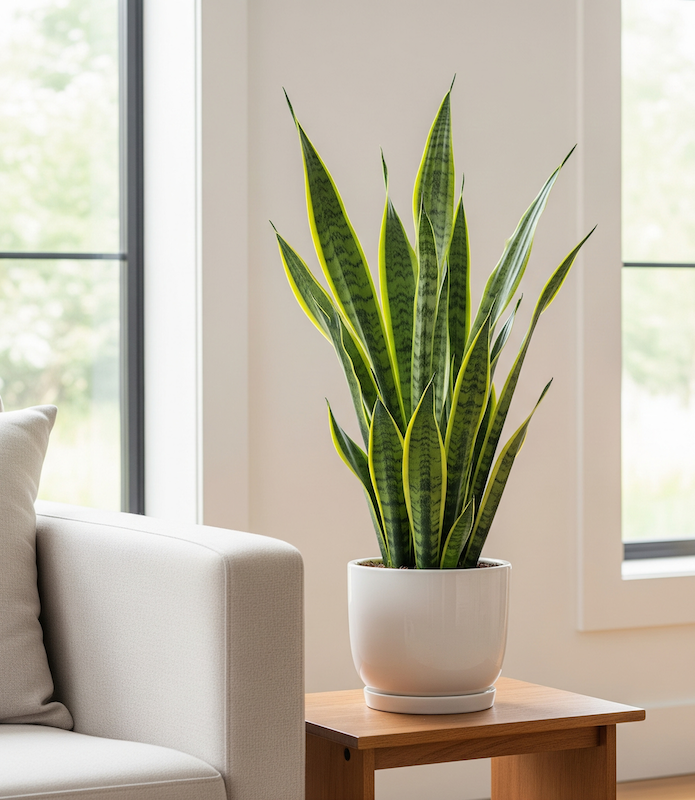 For instance, the Snake Plant (Sansevieria trifasciata) is a hardy option that removes toxins like benzene and formaldehyde and even releases oxygen at night, making it excellent for bedrooms. Spider Plants (Chlorophytum comosum) are cheerful and fast-growing, tackling formaldehyde, xylene, and carbon monoxide. The elegant Peace Lily (Spathiphyllum) is a powerhouse, absorbing benzene, formaldehyde, trichloroethylene, and ammonia, while also helping to reduce humidity.
For instance, the Snake Plant (Sansevieria trifasciata) is a hardy option that removes toxins like benzene and formaldehyde and even releases oxygen at night, making it excellent for bedrooms. Spider Plants (Chlorophytum comosum) are cheerful and fast-growing, tackling formaldehyde, xylene, and carbon monoxide. The elegant Peace Lily (Spathiphyllum) is a powerhouse, absorbing benzene, formaldehyde, trichloroethylene, and ammonia, while also helping to reduce humidity.
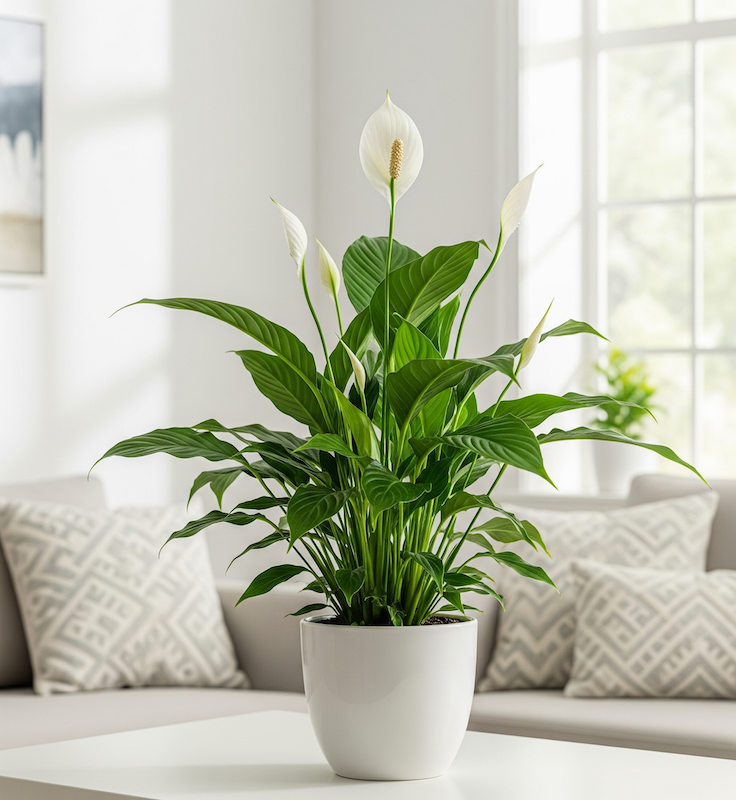 Other notable air-purifying plants include Florist's Chrysanthemum, Lady Palm, English Ivy, Areca Palm, Boston Fern, and Rubber Plant.
Other notable air-purifying plants include Florist's Chrysanthemum, Lady Palm, English Ivy, Areca Palm, Boston Fern, and Rubber Plant.
When selecting houseplants, it's important to consider their care requirements, such as light, water, and humidity needs, to ensure they thrive in specific rooms. For those new to plant care, low-maintenance varieties like the Snake Plant offer a practical starting point. However, a crucial consideration is pet and child safety. Some highly effective air-purifying plants, including Chrysanthemums, Peace Lilies, and English Ivy, are toxic if ingested. Safer alternatives, such as the Bamboo Palm, are available for homes with curious pets or young children.
To aid in selection, the following table summarizes key information for some top air-purifying plants:
Table 1: Top Air-Purifying Plants for a Healthy Home
| Plant Name | Toxins Removed (Examples) | Ideal Location/Light | Care Level | Pet Safe |
|---|---|---|---|---|
| Snake Plant | Formaldehyde, Benzene, Xylene, Toluene | Low to bright, indirect light | Easy | No |
| Spider Plant | Formaldehyde, Xylene, Carbon Monoxide | Bright, indirect light | Easy | Yes |
| Peace Lily | Formaldehyde, Benzene, Trichloroethylene, Ammonia | Low light to bright, indirect light | Moderate | No |
| Florist's Chrysanthemum | Formaldehyde, Xylene, Benzene, Ammonia | Bright light (cool temperature) | Moderate | No |
| Lady Palm | Formaldehyde, Ammonia | Bright, indirect light | Moderate | Yes |
| English Ivy | Formaldehyde, Benzene, Trichloroethylene, Xylene | Bright, indirect light; medium-high humidity | Moderate | No |
| Areca Palm | Formaldehyde, Xylene, Toluene | Bright, indirect light | Moderate | Yes |
| Boston Fern | Formaldehyde | Bright, indirect light; high humidity | Moderate | Yes |
| Rubber Plant | Formaldehyde | Bright, indirect light | Moderate | No |
| Bamboo Palm | Formaldehyde, Benzene, Trichloroethylene | Bright, indirect light; tolerates shade | Moderate | Yes |
Technological Reinforcements: Air Purifiers and Ventilation
While houseplants offer natural air purification, technological solutions like air purifiers and dedicated ventilation systems provide more intensive and targeted air quality control.
Air Purifiers: These devices are designed to remove a wide array of airborne contaminants, including dust, pollen, pet dander, mold spores, bacteria, and viruses, significantly improving indoor air quality and reducing the risk of respiratory issues and allergy symptoms.
High-Efficiency Particulate Air (HEPA) filters are a cornerstone of effective air purification. True HEPA filters are capable of capturing at least 99.97% of airborne particles as small as 0.3 microns, which includes many allergens and pathogens. This makes them particularly beneficial for individuals with allergies or asthma.
For gaseous pollutants, Volatile Organic Compounds (VOCs), and odors, purifiers equipped with Activated Carbon filters are recommended. These filters work by adsorbing gas molecules onto the surface of the carbon. Many advanced air purifiers combine HEPA and activated carbon filters for comprehensive air cleaning.
Other technologies like UV light and ionizers exist, but come with caveats. UV light can deactivate microorganisms like bacteria and viruses but does not remove particulate matter or gases. Ionizers work by causing particles to clump together and settle, but they may produce ozone, a lung irritant. When choosing an air purifier, looking at the Clean Air Delivery Rate (CADR) can help assess its effectiveness for particle removal, and ensuring a substantial amount of activated carbon is present is key for gas and odor filtration.
Ventilation Systems: Proper ventilation is crucial for exchanging stale indoor air with fresh outdoor air, reducing humidity, and removing accumulated pollutants. Modern homes, often built to be airtight for energy efficiency, can trap pollutants inside, making mechanical ventilation systems increasingly important.
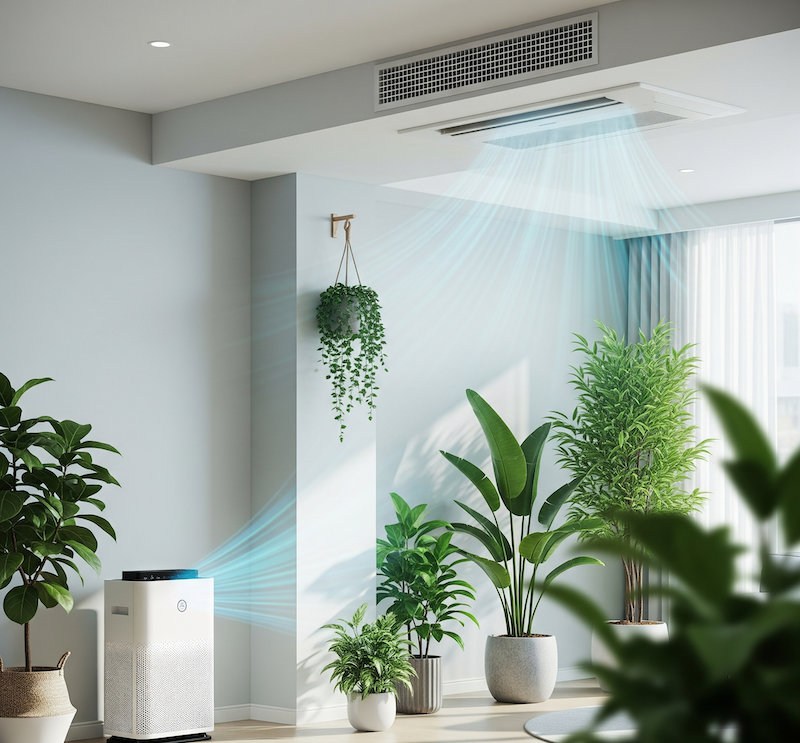 Heat Recovery Ventilators (HRVs) and Energy Recovery Ventilators (ERVs) are advanced systems that provide continuous fresh air while minimizing energy loss. HRVs transfer heat from the outgoing stale air to the incoming fresh air, while ERVs transfer both heat and moisture. The choice between an HRV and an ERV often depends on the climate; HRVs are generally suited for colder climates, while ERVs can be beneficial in climates with very dry winters or very humid summers, as they help maintain more balanced indoor humidity levels. Installation of these systems is typically a professional job, with costs ranging from approximately $1,500 to $4,600 or more, depending on the system and complexity. While DIY installation is highly complex and generally not recommended for homeowners without significant HVAC experience, regular maintenance, including filter cleaning and replacement (every three to six months for HRV/ERV filters) and periodic core cleaning, is essential for optimal performance and longevity.
Heat Recovery Ventilators (HRVs) and Energy Recovery Ventilators (ERVs) are advanced systems that provide continuous fresh air while minimizing energy loss. HRVs transfer heat from the outgoing stale air to the incoming fresh air, while ERVs transfer both heat and moisture. The choice between an HRV and an ERV often depends on the climate; HRVs are generally suited for colder climates, while ERVs can be beneficial in climates with very dry winters or very humid summers, as they help maintain more balanced indoor humidity levels. Installation of these systems is typically a professional job, with costs ranging from approximately $1,500 to $4,600 or more, depending on the system and complexity. While DIY installation is highly complex and generally not recommended for homeowners without significant HVAC experience, regular maintenance, including filter cleaning and replacement (every three to six months for HRV/ERV filters) and periodic core cleaning, is essential for optimal performance and longevity.
It becomes clear that a multifaceted strategy often yields the best results for indoor air quality. Houseplants contribute to a baseline level of purification and aesthetic appeal, while HEPA and activated carbon air purifiers target specific particulate and gaseous pollutants respectively. Ventilation systems, like HRVs or ERVs, then manage the overall air exchange, ensuring a constant supply of fresh air and removal of stale, humid air. This layered approach addresses a broader spectrum of air quality concerns than any single solution could manage alone.
Furthermore, the choices made in building materials, which will be discussed later, have a direct bearing on indoor air quality. Materials that off-gas high levels of VOCs place a greater burden on air purification and ventilation systems. Thus, selecting low-VOC materials from the outset can reduce the demand on these systems and contribute to a healthier indoor environment with less effort. Beyond direct respiratory health, the benefits of improved indoor air quality ripple outwards. For instance, cleaner air can contribute to better sleep quality, which in turn positively affects mood, concentration, and overall productivity. By minimizing airborne irritants and allergens, a healthier indoor atmosphere allows occupants to feel more comfortable and focused throughout their day.
The Elixir Within Your Walls: Ensuring Pure Water
The quality of water flowing through our homes is fundamental to our health and daily routines. Clean water is essential not only for drinking and cooking but also for bathing and even maintaining the longevity of plumbing and appliances. Unfiltered tap water can harbor various contaminants, including chlorine, lead, bacteria, pesticides, and heavy metals, which may pose health risks such as gastrointestinal issues and skin problems if consumed or absorbed over time. Investing in water filtration is an investment in the household's well-being.
Decoding Water Filtration: Systems and Solutions
A variety of water filtration systems are available, each designed to target different contaminants and suit various household needs and budgets. These can broadly be categorized into whole-house systems and point-of-use systems.
Whole-House Water Filtration Systems are installed on the main water line, providing filtered water to every faucet and shower in the home. Common types include:
- Activated Carbon Filters: These are effective at removing chlorine, volatile organic compounds (VOCs), pesticides, herbicides, and improving the taste and odor of water.
- Sediment Filters: These act as a first line of defense, removing larger particles like sand, silt, rust, and other debris that can make water cloudy and clog other filters or appliances.
- Water Softeners (Ion Exchange Systems): Specifically designed to address hard water by removing minerals like calcium and magnesium. This prevents scale buildup in pipes and appliances, improves soap and detergent efficiency, and can lead to softer skin and hair.
- Ultraviolet (UV) Purification Systems: Use UV light to disinfect water by killing bacteria, viruses, and other microorganisms without the use of chemicals. These are particularly useful for homes with well water.
- Reverse Osmosis (RO) Systems (Whole House): Considered one of the most comprehensive filtration methods, RO systems can remove up to 99% of total dissolved solids (TDS), including heavy metals (like lead and arsenic), chlorine, fluoride, nitrates, bacteria, and viruses. However, they are typically the most expensive whole-house option.
Point-of-Use (POU) Systems filter water at a single point, such as a kitchen sink or showerhead.
- Under-Sink RO Systems: A popular choice for high-quality drinking water directly from the kitchen tap. These systems typically involve multiple stages of filtration, including sediment pre-filters, carbon pre-filters, the RO membrane itself, and often a post-carbon filter to polish the taste.
- Faucet-Mounted Filters, Countertop Filters, and Water Filter Pitchers: These are generally more affordable and easier to install, often relying on activated carbon to improve taste and odor and remove some contaminants. Their capacity and filtration range are typically more limited than under-sink or whole-house systems.
- Shower Filters: Specifically designed to reduce chlorine and other contaminants from shower water, which can benefit skin and hair health.
To help homeowners navigate these options, the following table provides a comparison:
Table 2: Comparing Home Water Filtration Systems
| System Type | Key Contaminants Removed | Avg. Installation Cost Range (System + Labor) | Typical Maintenance & Frequency | Pros | Cons |
|---|---|---|---|---|---|
| Whole-House Activated Carbon | Chlorine, VOCs, pesticides, taste, odor | $850 - $2,500+ | Cartridge: 3-6 months; Backwashing Media: 3-5 years | Improves water quality throughout home, better taste/odor. | Doesn't remove minerals, heavy metals, or microorganisms effectively on its own. |
| Whole-House Sediment Filter | Dirt, rust, sand, silt | Included in many systems or $850+ standalone | Clean/replace: 1-12 months depending on type/sediment levels | Protects plumbing & appliances, pre-filters for other systems. | Only removes larger particles. |
| Whole-House Water Softener | Calcium, magnesium (hardness minerals) | $1,500 - $5,400+ (can be part of combo system) | Salt replenishment (monthly); Resin bed (10-15+ years) | Prevents scale, softer skin/hair, improves soap efficiency. | Adds sodium to water (some models use potassium), doesn't purify. |
| Whole-House UV Purifier | Bacteria, viruses, protozoa | $800 - $2,900+ (can be part of combo system) | UV lamp: yearly; Quartz sleeve: clean every 6 months, replace if damaged | Chemical-free disinfection, effective against microorganisms. | Doesn't remove sediment, chemicals, or heavy metals; requires pre-filtration for cloudy water. |
| Whole-House Reverse Osmosis (RO) | TDS, heavy metals, chlorine, fluoride, nitrates, bacteria, viruses | $4,800 - $8,000+ | Pre/post filters: 6-12 months; RO membrane: 2-5 years | Most comprehensive filtration, highest purity water. | Most expensive, produces wastewater, may remove beneficial minerals (remineralization stage can be added). |
| Under-Sink Reverse Osmosis (RO) | TDS, heavy metals, chlorine, fluoride, nitrates, bacteria, viruses (at one tap) | $170 - $950+ | Pre/post filters: 6-12 months; RO membrane: 24 months | High-quality drinking water, relatively affordable for targeted use. | Produces wastewater, may remove beneficial minerals, requires under-sink space. |
| Shower Filter | Chlorine, some other chemicals | $20 - $100+ | Cartridge: ~6 months | Softer skin/hair, reduced chlorine inhalation. | Only filters shower water. |
Practicalities: Installation, Maintenance, and Costs
The implementation of water filtration systems involves several practical considerations.
Installation: While some simpler POU systems like faucet filters and pitchers require no specialized installation, under-sink RO systems can often be a DIY project for those comfortable with basic plumbing. Key steps for a DIY under-sink RO installation typically include shutting off the cold water supply, drilling a hole for the dedicated RO faucet (if one isn't available), mounting the faucet, installing a drain saddle on the drainpipe, connecting a feed water adapter valve to the cold water line, making color-coded tubing connections between the system components (filters, tank, faucet, drain), and mounting the filter assembly and tank under the sink. Tools often needed include an adjustable wrench, drill, and plumber's tape. Common challenges can include ensuring leak-free connections and correctly routing the tubing. Whole-house systems, however, generally require professional installation by a plumber or a certified water treatment specialist, with labor costs typically ranging from $200 to $600.
Maintenance: Regular maintenance is paramount for any water filtration system to perform effectively and safely. The most common task is filter replacement. For whole-house activated carbon systems, this might involve replacing cartridges every few months or, for larger backwashing systems, replacing the carbon media every 3 to 5 years. The general steps for replacing a whole-house filter cartridge include shutting off the main water supply to the system, releasing any built-up pressure (often via a red button on the filter housing), unscrewing the filter housing (a filter wrench is usually required), removing the old cartridge, cleaning the inside of the housing, inserting the new cartridge (ensuring correct orientation), checking and lubricating the O-ring, reattaching the housing, and then slowly turning the water back on while checking for leaks. UV systems require annual lamp replacement and periodic cleaning of the quartz sleeve. RO systems need pre-filter and post-filter changes every 6-12 months and membrane replacement every 2-5 years.
Cost Considerations: The overall cost encompasses the initial price of the system, professional installation fees if applicable, ongoing expenses for replacement filters or media, and potentially additional costs for necessary plumbing modifications or the installation of an electrical outlet for systems like UV purifiers.
Water Testing: Before investing in any system, it is highly advisable to have the home's water professionally tested. Testing, which can cost between $100 and $300, will identify specific contaminants present and their levels, guiding the selection of the most appropriate and cost-effective filtration solution.
The advantages of investing in water filtration are multifaceted. Beyond the direct health benefits of consuming cleaner water, there are notable financial and environmental upsides. Reducing reliance on bottled water translates to direct cost savings and a significant decrease in plastic waste, contributing to environmental sustainability. Furthermore, by removing minerals and sediments that can cause scale buildup and corrosion, filtration systems can extend the lifespan of plumbing and water-using appliances like dishwashers and water heaters, deferring replacement costs.
An often-overlooked aspect is the connection between water quality and air quality. For example, chlorine and other volatile chemicals present in municipal water can vaporize during a hot shower and be inhaled. By installing whole-house filtration or even just a chlorine-reducing shower filter, homeowners can lessen their exposure to these airborne chemicals, thereby contributing to better indoor air quality and respiratory health. Ultimately, the provision of clean, good-tasting water can also encourage healthier habits, such as increased water consumption, which is fundamental to overall wellness.
Illuminating Wellness: Lighting for Body and Mind
Light is a powerful environmental factor that extends far beyond simple visibility. It profoundly influences our internal biological clocks, known as circadian rhythms, and regulates the production of key hormones like melatonin (for sleep) and serotonin (for mood). Consequently, the lighting in our homes can significantly affect our mood, sleep patterns, energy levels, and overall productivity. Thoughtful lighting design is a cornerstone of a wellness-focused home.
Embracing the Sun: Maximizing Natural Light
 Natural sunlight is a potent wellness tool. Exposure to daylight helps regulate our sleep-wake cycles, boosts mood, can increase serotonin production, and is a natural source of Vitamin D. Maximizing its presence indoors is a simple yet impactful upgrade.
Natural sunlight is a potent wellness tool. Exposure to daylight helps regulate our sleep-wake cycles, boosts mood, can increase serotonin production, and is a natural source of Vitamin D. Maximizing its presence indoors is a simple yet impactful upgrade.
Homeowners can enhance natural light by:
- Using sheer curtains or light-filtering window treatments that allow sunlight to enter while maintaining privacy.
- Strategically placing mirrors opposite windows to reflect and bounce light deeper into rooms.
- Keeping windows clean and free of obstructions.
- During renovations, considering open floor plans or incorporating glass partitions to allow light to flow more freely.
- Arranging furniture to take full advantage of the natural light available from windows.
Intelligent Illumination: Circadian Rhythm and Smart Lighting
Beyond maximizing natural light, advanced lighting technologies can supplement and mimic the sun's patterns to support our well-being.
Circadian Rhythm Lighting Systems are designed to mirror the natural progression of daylight, automatically adjusting their brightness and color temperature throughout the day. These systems typically provide bright, blue-enriched light in the morning to promote alertness and gradually transition to warmer, dimmer light in the evening to signal the body to wind down for sleep. This alignment with natural light cycles can lead to improved sleep quality, enhanced mood, increased productivity, and may even reduce the risk of certain health issues like sleep disorders and depression.
Human-Centric Lighting is a broader concept that focuses on how light impacts the human body and mind, aiming to support sleep cycles, alertness, and overall comfort by delivering the right kind of light at the right time.
Tunable White Lighting offers the flexibility to manually adjust the color temperature of light, or to set schedules for automatic changes, allowing users to shift from cool white light during daytime activities to a warm white glow in the evenings. DIY solutions using tunable white LED strip lights are becoming increasingly accessible for accent and ambient lighting.
Smart Lighting solutions, offered by brands like Philips Hue, LIFX, GE Cync, and high-end systems like Lutron's Ketra, make implementing wellness-focused lighting easier. Features often include automated adjustments based on time of day, voice control, and even sunrise simulation to gently wake users. Individual smart bulbs provide an affordable entry point, while whole-home systems offer comprehensive and sophisticated control but represent a more significant investment. For instance, a Lutron Homeworks system might range from $8 to $30 per square foot, while individual Ketra fixtures can vary widely in price. Recessed circadian lights can cost around $30 to $50+ per unit, excluding installation. Full system installations require professional electricians and programmers, and costs are highly dependent on the project's complexity, the number and type of fixtures, and the sophistication of the control system.
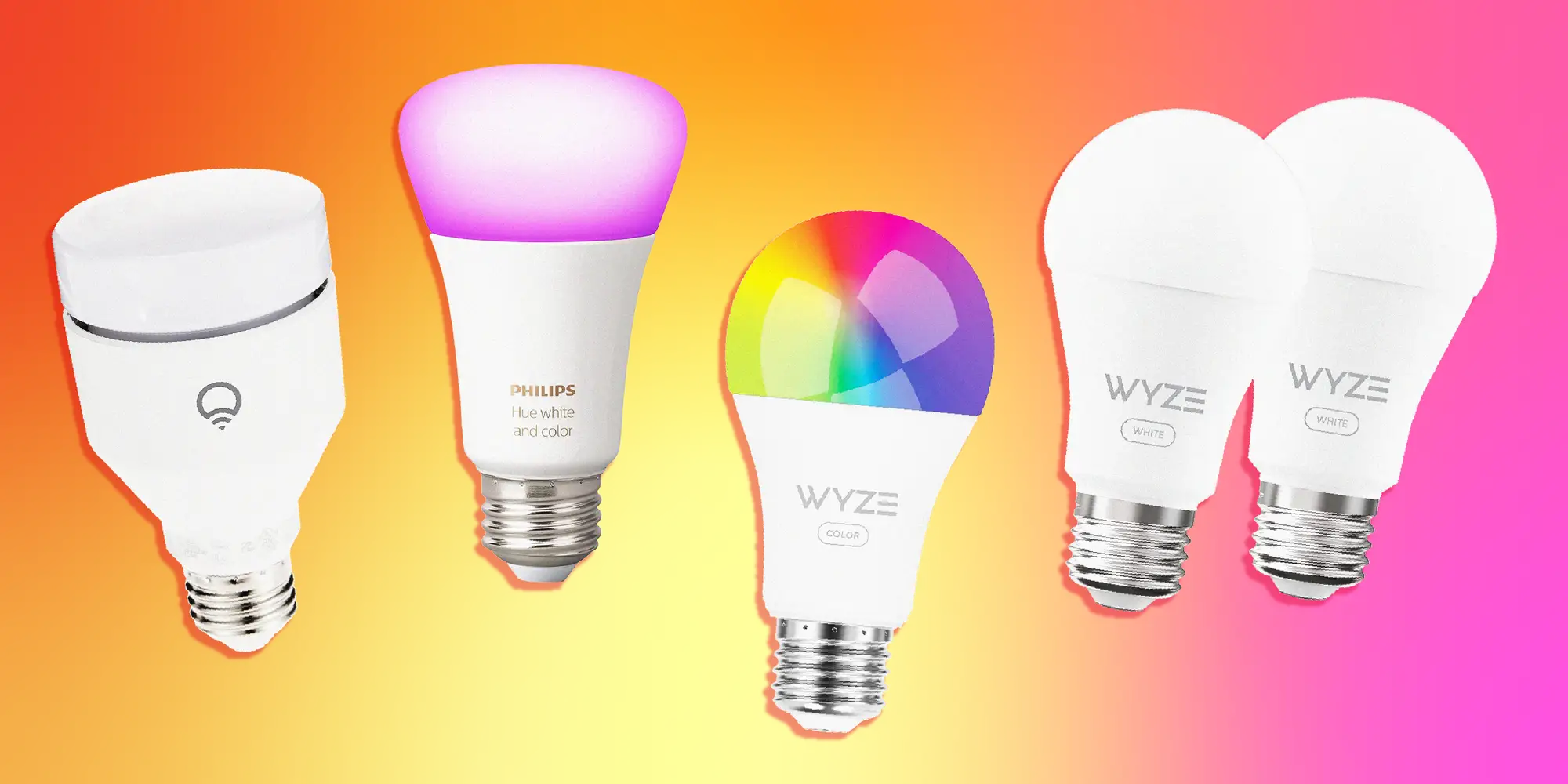 To optimize lighting for well-being, consider the time of day and the function of each room:
To optimize lighting for well-being, consider the time of day and the function of each room:
- Morning (6 AM - 10 AM): Cool, bright light (higher Kelvin) helps in waking up and boosting alertness.
- Midday (10 AM - 2 PM): Maintain bright, neutral light to support focus and energy.
- Afternoon (2 PM - 6 PM): Transition to softer, slightly warmer light as the body prepares to wind down.
- Evening (6 PM - 10 PM): Use warm, dim light (lower Kelvin) to promote relaxation and melatonin production. Avoid bright, blue-toned light from screens and overhead fixtures.
- Night (10 PM onwards): Keep lighting minimal, using warm-toned night lights if needed, especially with motion sensors in hallways or bathrooms.
Table 3: Recommended Light Temperatures (Kelvin) for Home Sanctuaries
| Room | Recommended Kelvin Range | Rationale |
|---|---|---|
| Bedroom | 2700K – 3000K | Warm and calming, conducive to relaxation and sleep |
| Living Room | 2700K – 3500K | Cozy and flexible for various activities |
| Kitchen | 3500K – 4100K | Bright and energizing for tasks |
| Home Office | 4000K – 5000K | Cool and focused for productivity |
| Bathroom | 3000K – 4000K | Bright but flattering for grooming |
Using dimmers or tunable bulbs allows for easy adjustment as needed.
Strategic lighting serves as a powerful, non-invasive tool for enhancing mental wellness. It can play a role in mitigating conditions like Seasonal Affective Disorder (SAD) and generally improving mood, extending its benefits far beyond simple task illumination. The positive impact on mood and potential reduction in depression risk underscore the therapeutic potential of well-considered lighting choices.
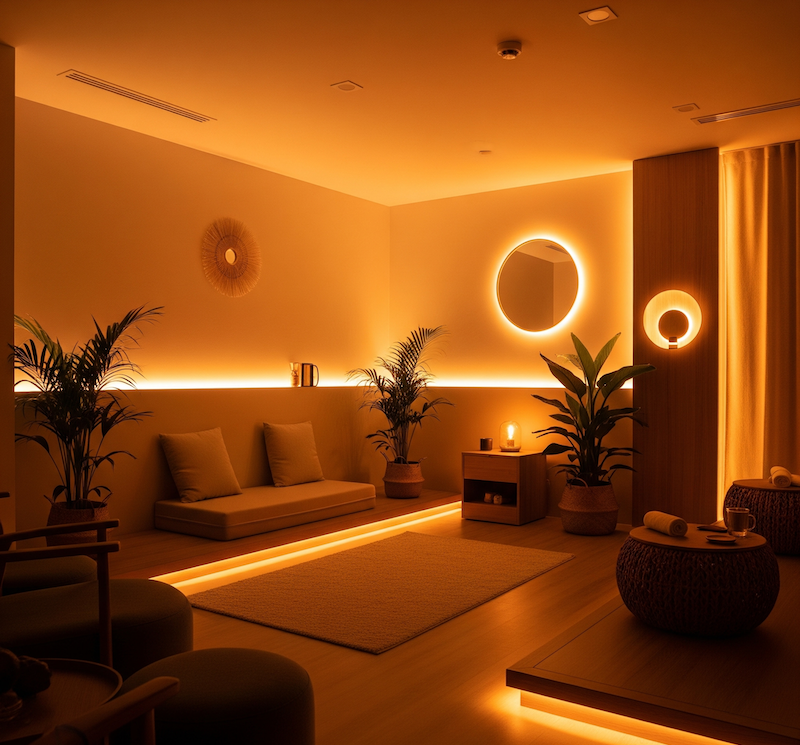 It's also important to recognize that the effectiveness of circadian lighting systems is amplified when they complement, rather than entirely replace, good natural light strategies. These systems are designed to mimic and supplement the natural light spectrum. If a home poorly manages its natural light resources, artificial systems may struggle to achieve their full potential or may feel less harmonious with the body's innate expectations. Thus, maximizing natural light and implementing intelligent artificial lighting are synergistic approaches for optimal well-being. Looking ahead, as smart home technology becomes increasingly sophisticated and integrated, with AI-powered systems capable of bio-tracking and adapting environments in real-time, lighting will likely become even more personalized. Future homes may feature lighting that dynamically adjusts not just to the time of day, but to the occupants' current physiological and emotional states, ushering in a new era of proactive wellness support.
It's also important to recognize that the effectiveness of circadian lighting systems is amplified when they complement, rather than entirely replace, good natural light strategies. These systems are designed to mimic and supplement the natural light spectrum. If a home poorly manages its natural light resources, artificial systems may struggle to achieve their full potential or may feel less harmonious with the body's innate expectations. Thus, maximizing natural light and implementing intelligent artificial lighting are synergistic approaches for optimal well-being. Looking ahead, as smart home technology becomes increasingly sophisticated and integrated, with AI-powered systems capable of bio-tracking and adapting environments in real-time, lighting will likely become even more personalized. Future homes may feature lighting that dynamically adjusts not just to the time of day, but to the occupants' current physiological and emotional states, ushering in a new era of proactive wellness support.
Nature's Embrace: Integrating Biophilic Design
In our increasingly urbanized lives, the innate human need to connect with nature often goes unmet. Biophilic design seeks to address this by consciously incorporating natural elements, patterns, and processes into the built environment. It's a philosophy that recognizes that our well-being is deeply intertwined with the natural world, and it extends far beyond simply adding a few potted plants to a room. The benefits are substantial, including reduced stress levels, improved mood, enhanced cognitive function and creativity, and even faster recovery from illness.
Bringing the Outdoors In: Key Biophilic Principles & Patterns
The principles of biophilic design can be understood through frameworks like Terrapin Bright Green's "14 Patterns of Biophilic Design", which are broadly categorized into experiencing nature directly, experiencing natural analogues, and experiencing the nature of the space.
1. Nature in the Space (Direct Experience of Nature): This involves bringing actual elements of the natural world into the home.
- Visual Connection with Nature: This is about providing views of living systems, plants, water, and natural processes. In apartments or homes with limited outdoor views, this can be achieved by maximizing existing window outlooks, cultivating a diverse collection of indoor plants, or even using high-quality nature-themed artwork, photography, or murals if direct views or abundant plants are not feasible.
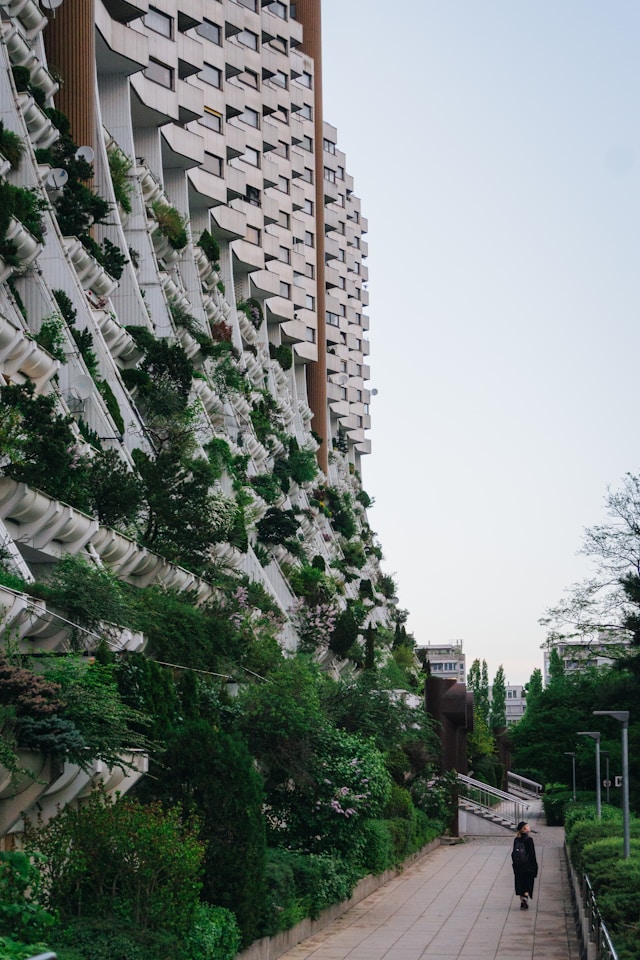
- Non-Visual Connection with Nature: Engaging other senses through auditory stimuli (like the sound of rain, birdsong, or flowing water), olfactory experiences (natural, pleasant scents from plants or essential oils), and haptic sensations (the feel of natural materials) creates a richer connection. Budget-friendly options include small indoor water fountains (DIY versions are possible), using natural fiber textiles (cotton, linen, wool), diffusing essential oils like lavender or citrus, and simply opening windows to allow in natural sounds and breezes.

- Presence of Water: The sight, sound, or touch of water is inherently calming and restorative. Tabletop fountains, small, low-maintenance aquariums, or even decorative bowls filled with water and floating petals or smooth stones can introduce this element affordably into smaller living spaces.
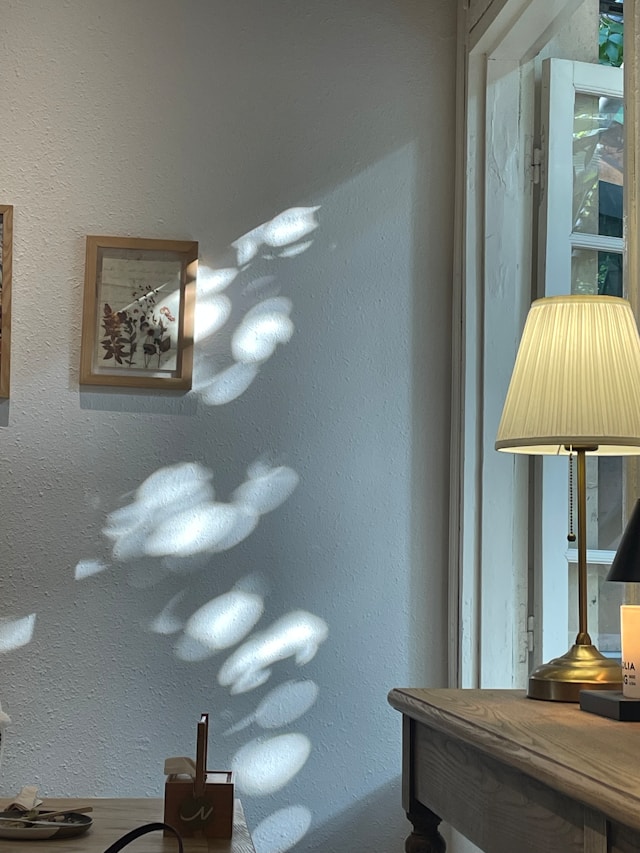
- Dynamic & Diffuse Light: Mimicking the varying intensities of light and shadow found in nature, such as dappled sunlight through leaves, can create a more stimulating and visually comfortable environment. This can be achieved by using sheer curtains to soften and diffuse incoming sunlight or by layering artificial light sources to create varied illumination levels.
2. Natural Analogues (Indirect Experience of Nature): This involves using materials, forms, patterns, and textures that evoke nature.
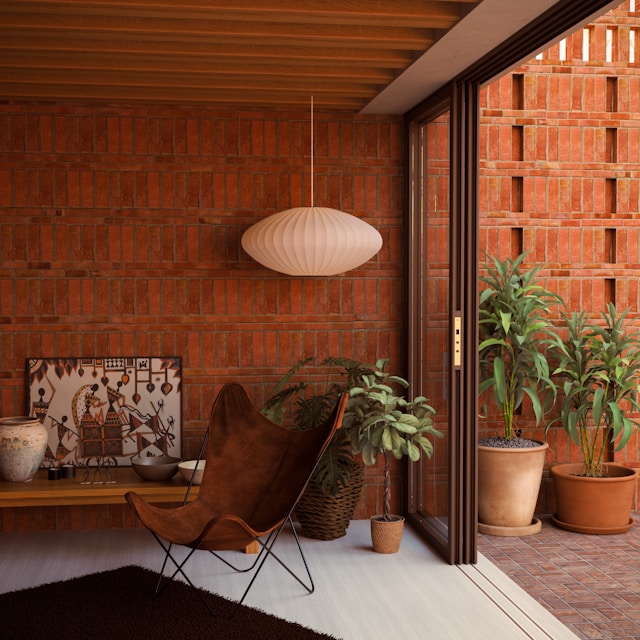
- Biomorphic Forms & Patterns: These are symbolic references to shapes, patterns, and textures that persist in the natural world, such as the curves of a flower petal, the branching of a tree, spiral patterns, or the veining in a leaf. These can be incorporated affordably through textiles like cushions or rugs featuring botanical or organic motifs, wallpapers with subtle nature-inspired patterns, artwork, or decorative objects with curved, flowing lines rather than harsh, straight ones.
- Material Connection with Nature: Using materials that are clearly derived from nature and have undergone minimal processing helps to create a tangible link to the outdoors. Examples include wood (especially reclaimed or sustainably sourced), stone, bamboo, cork, rattan, wool, cotton, and linen. For those on a budget, this could mean opting for a wooden coffee table, stone coasters, a jute or sisal rug, or cotton and linen throws and cushion covers.

- Complexity & Order: This pattern refers to creating environments with rich sensory information that adheres to a spatial hierarchy similar to those encountered in nature, providing interest without overwhelming. This might be achieved by arranging groupings of plants with varying heights, textures, and colors, or creating a gallery wall of nature photography that offers visual diversity within an ordered framework.
3. Nature of the Space (Spatial Experience): This category relates to how spatial configurations can mimic experiences found in natural environments.
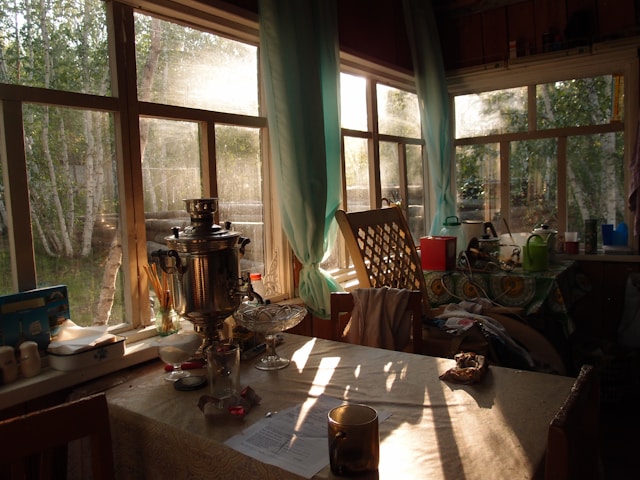
- Prospect: This pattern provides an unimpeded view over a distance, which can evoke feelings of openness, awareness, and control. In an apartment or small home, this can be achieved by arranging furniture to maximize the longest possible view, perhaps towards a window or across an open-plan area. Keeping window areas uncluttered is key.
- Refuge: This refers to creating spaces where one can withdraw and feel protected, typically with a sense of enclosure from behind and overhead. Budget-friendly refuge spaces can be created by designating a cozy reading nook in a corner with a comfortable chair, soft lighting, plush cushions, and perhaps a throw blanket. A high-backed armchair or a simple canopy can enhance this feeling.
- Mystery: This pattern involves partially obscured views or other sensory cues that entice exploration and create a sense of anticipation. In smaller homes, mystery can be introduced subtly using translucent screens, strategically placed tall plants that partially veil an area, or arranging furniture to create intriguing glimpses into adjacent spaces rather than revealing everything at once.
Biophilia on a Budget: Practical Tips for Every Home
Incorporating biophilic design doesn't necessitate expensive overhauls. Many impactful changes can be made affordably:
- Start Small: Introduce a few well-chosen, low-maintenance houseplants like snake plants or pothos.
- Natural Textiles: Opt for cushion covers, throws, or small rugs made from cotton, linen, or jute.
- Maximize Light: Keep windows clean and use sheer curtains.
- DIY Decor: Create your own nature-inspired artwork, press flowers, or use foraged items like smooth stones or driftwood as decorative accents. Repurpose old jars or containers as planters.
- Vertical Greenery: For small apartments, vertical gardens or wall-mounted planters can add significant greenery without taking up floor space.
The principles of biophilic design are often inherently linked with sustainability. The preference for natural, minimally processed materials like wood, stone, and natural fibers frequently aligns with more eco-conscious choices, especially when these materials are locally sourced or reclaimed. This synergy means that embracing biophilic design can naturally lead to a home that is not only more supportive of personal well-being but also more environmentally responsible.
Furthermore, the "Nature of the Space" patterns, such as prospect and refuge, subtly address deep-seated psychological needs for safety, awareness, and control. A clear view can reduce feelings of vulnerability, while a cozy, protected nook offers a genuine sense of security and an opportunity for mental respite. These spatial qualities can significantly influence stress levels and overall mental comfort in ways that are often subconscious yet powerful. As global populations continue to urbanize and daily life becomes more detached from the natural world, the integration of biophilic design into our homes transforms from a mere aesthetic preference into a vital strategy for counteracting nature deficit and bolstering mental and physical health within city environments.
Conscious Construction: Choosing Non-Toxic & Sustainable Materials
The materials used to build and furnish our homes form the very fabric of our daily environment, and their selection has significant implications for both our health and the planet's well-being. Conventional building products can release Volatile Organic Compounds (VOCs) and other harmful chemicals into the indoor air, contributing to air pollution and potentially causing health issues ranging from irritation to more serious conditions. A wellness-focused home prioritizes materials that are non-toxic, sustainable, and contribute to a healthier indoor environment.
Key Areas for Healthier Material Selection
Several categories of building materials warrant careful consideration when aiming for a healthier home. Paints and finishes are a common source of VOCs, which are chemicals that can off-gas into the air at room temperature, leading to health concerns such as eye, nose, and throat irritation, headaches, and nausea. The good news is that the market for low-VOC or zero-VOC paints has expanded significantly. When selecting paints, look for these labels. While latex-based (water-based) paints are generally less toxic and emit fewer VOCs than traditional oil-based paints, not all latex formulas are inherently low-VOC, so checking the product specifications is crucial. Encouragingly, many low-VOC and no-VOC paints are now cost-competitive with their conventional counterparts, making this a readily accessible healthy upgrade.
Flooring: Stepping Towards Sustainability
Flooring covers a large surface area and can significantly impact indoor air quality and comfort. Healthier, more sustainable options include:
- Cork: Harvested from the bark of cork oak trees (a renewable resource), cork flooring is naturally comfortable underfoot, antimicrobial, and an excellent sound absorber. It's a great choice for bedrooms and living areas. The main consideration is ensuring it's properly sealed to prevent moisture damage. Cost can be comparable to bamboo, with some estimates around £50 per square meter and up.
- Bamboo: A fast-growing grass, bamboo is a highly renewable material that is also durable and offers a sleek, modern aesthetic. However, it can be slippery and sensitive to moisture if not properly finished or maintained. Costs typically range from approximately £25 to £80 per square meter.
- Reclaimed Hardwood: Using salvaged wood from old buildings or barns not only diverts waste from landfills but also adds unique character and history to a home. When sourcing reclaimed wood, it's important to choose reputable suppliers and inspect the wood for dryness, structural integrity, signs of pests (like sawdust or soft spots), and potential contaminants like lead paint, especially if the wood is from structures built before 1978. Proper handling, such as sanding outdoors and using HEPA filtration, is essential if lead paint is suspected. Look for transparent sourcing or certifications where possible.
- Natural Linoleum (e.g., Marmoleum): Unlike vinyl, true linoleum is made from natural, renewable materials such as linseed oil, wood flour, rosin, limestone, and jute. It is biodegradable and does not off-gas harmful VOCs. When choosing any flooring, it's advisable to look for products with low-VOC or zero-VOC certifications and to use water-based, low-emission adhesives and finishes. Avoid flooring options known for high formaldehyde or phthalate content unless they are certified for low emissions.
Insulation: Wrapping Your Home in Wellness
Insulation plays a critical role in energy efficiency and thermal comfort, but material choices also impact health. Natural and bio-based insulation options are gaining traction:
- Hemp Insulation (e.g., Hemp Batts, HempWool®): Made from the fibers of the industrial hemp plant, this insulation is considered carbon-negative as hemp absorbs more CO2 during its growth than is emitted during its processing. It offers good thermal resistance (R-value around R-3.5 to R-3.7 per inch), is breathable, helps regulate moisture (reducing mold risk), and provides sound dampening. The cost is generally higher than fiberglass, ranging from $1.40 to $3.10 per square foot, compared to $0.30 to $1.50 for fiberglass.
- Sheep's Wool Insulation: A natural, non-toxic, and renewable insulator, sheep's wool has excellent thermal and acoustic properties and can help regulate indoor humidity by absorbing and releasing moisture.
- Cellulose Insulation: Primarily made from recycled paper products (like newspaper) treated with fire retardants, cellulose is an eco-friendly option with good thermal performance (R-value typically R-3.2 to R-3.8 per inch). Costs range from about $0.50 to $1.80 per square foot installed.
- Hempcrete: A composite material made from hemp hurd (the woody inner part of the hemp stalk) and a lime-based binder, hempcrete is fire-resistant, breathable, and acts as a carbon sink. It is not a load-bearing material like traditional concrete but can be used for walls in conjunction with a structural frame. While the initial cost can be significantly higher than conventional concrete (potentially adding $60 or more per square foot to a traditional build cost), it offers long-term benefits in energy efficiency and indoor air quality.
For comparison, conventional fiberglass insulation is generally cheaper (approx. $0.30-$1.50 per square foot) and has an R-value of R-3.0 to R-4.3 per inch, but it can pose health risks during installation if not handled properly (itchy fibers) and has a higher embodied energy compared to many bio-based options.
Table 4: Eco-Friendly & Healthy Material Snapshot
| Material Category | Specific Material | Key Health/Eco Benefit | Avg. Cost Comparison (vs. Conventional) | Key Considerations/Certifications |
|---|---|---|---|---|
| Paint | Low-VOC / Zero-VOC Paint | Reduced off-gassing of harmful chemicals, improved indoor air quality. | Often comparable | Check VOC content (g/L); Greenguard, Green Seal. |
| Flooring | Cork | Renewable, antimicrobial, comfortable, sound-absorbent. | Moderate (similar to bamboo) | Requires sealing in moist areas; Look for FSC certification for cork. |
| Flooring | Bamboo | Rapidly renewable, durable, modern aesthetic. | Moderate | Quality varies; can be moisture-sensitive; look for low-VOC adhesives/finishes. |
| Flooring | Reclaimed Hardwood | Reduces deforestation, diverts waste, unique character. | Varies (can be higher) | Source from reputable dealers; inspect for pests, lead paint, structural integrity. FSC Recycled. |
| Insulation | Hemp Insulation | Carbon-negative, breathable, moisture-regulating, non-toxic. | Higher than fiberglass | Good R-value (3.5-3.7/inch). |
| Insulation | Sheep's Wool | Natural, non-toxic, renewable, humidity-regulating, good thermal/acoustic insulation. | Higher than fiberglass | Naturally flame resistant. |
| Insulation | Cellulose | High recycled content, good thermal performance. | Comparable to slightly higher than fiberglass | Treated with fire retardants (borates are common). R-value (3.2-3.8/inch). |
| Wall Construction | Hempcrete | Carbon-sequestering, breathable, fire-resistant, good insulation. | Significantly higher initially | Not load-bearing; requires specific building techniques. |
Decoding Labels: Understanding Material Certifications
Navigating the world of "green" and "healthy" materials can be confusing. Third-party certifications provide assurance that products meet specific standards for health, sustainability, and environmental impact. Key certifications to look for include:
- Greenguard / Greenguard Gold: These certifications ensure that products have met stringent chemical emissions limits, contributing to healthier indoor air by reducing VOCs. This is particularly important for products used extensively indoors, like flooring, furniture, and insulation.
- Cradle to Cradle Certified®: This is one of the most comprehensive and rigorous standards, evaluating products across five critical sustainability categories: material health (safe for humans and the environment), product circularity (design for recycling and reuse), clean air and climate protection, water and soil stewardship, and social fairness.
- Forest Stewardship Council (FSC): For wood and paper products, the FSC label guarantees that the materials come from forests that are managed responsibly to meet high environmental and social standards. This applies to new wood, bamboo (which is a grass but sometimes FSC certified), and reclaimed wood products.
- Green Seal: (Although specific details are not in the provided snippets, Green Seal is a recognized eco-label for various product categories, indicating lower environmental impact and sometimes healthier attributes.)
- CertiPUR-US®: This certification applies to flexible polyurethane foam used in items like mattresses and upholstered furniture. It ensures the foam is made without ozone depleters, certain flame retardants, heavy metals, formaldehyde, and regulated phthalates, and has low VOC emissions for indoor air quality.
- Declare Label: Often described as a "nutrition label for building products," the Declare label provides transparency by listing all intentionally added ingredients in a product, highlighting any Red List chemicals (substances known to be harmful). This empowers consumers and designers to make more informed choices.
While the initial investment in some sustainable and non-toxic materials might be higher than their conventional counterparts, a broader perspective reveals potential long-term savings. These can accrue from improved occupant health (leading to fewer illnesses, reduced allergy symptoms, and subsequently lower medical expenses or less missed work/school), enhanced durability of materials, and potentially lower utility bills due to better energy performance (e.g., from superior insulation). Therefore, evaluating materials based on their lifecycle cost and overall contribution to well-being, rather than solely on upfront price, is a more holistic approach.
Interestingly, the pursuit of biophilic design—which emphasizes connection to nature through natural materials, patterns, and light—often naturally leads to the selection of non-toxic and sustainable materials. For example, choosing solid, FSC-certified wood over particleboard laden with formaldehyde-based glues aligns with both biophilic principles and healthier material standards. This synergy means that designing for a connection to nature can simultaneously create a more environmentally responsible and healthier indoor space. The growing consumer awareness and demand for transparency in product ingredients, evidenced by initiatives like the Declare label, and for certified non-toxic materials are positive forces. This market pressure is encouraging manufacturers to innovate and produce healthier, more sustainable products, which, over time, should lead to greater accessibility and potentially more competitive pricing.
Spaces to Thrive: Dedicated Zones for Fitness and Serenity
Creating dedicated areas within the home for physical activity and mental relaxation is a powerful strategy for fostering consistent healthy habits and reducing the stresses of daily life. These intentional spaces, whether a fully equipped home gym or a tranquil meditation nook, signal a commitment to self-care and provide accessible sanctuaries for rejuvenation.
Energize Your Body: Designing a Home Fitness Space
A home fitness space can be tailored to any level of activity and available area, from a simple corner for mat exercises to a converted room or garage.
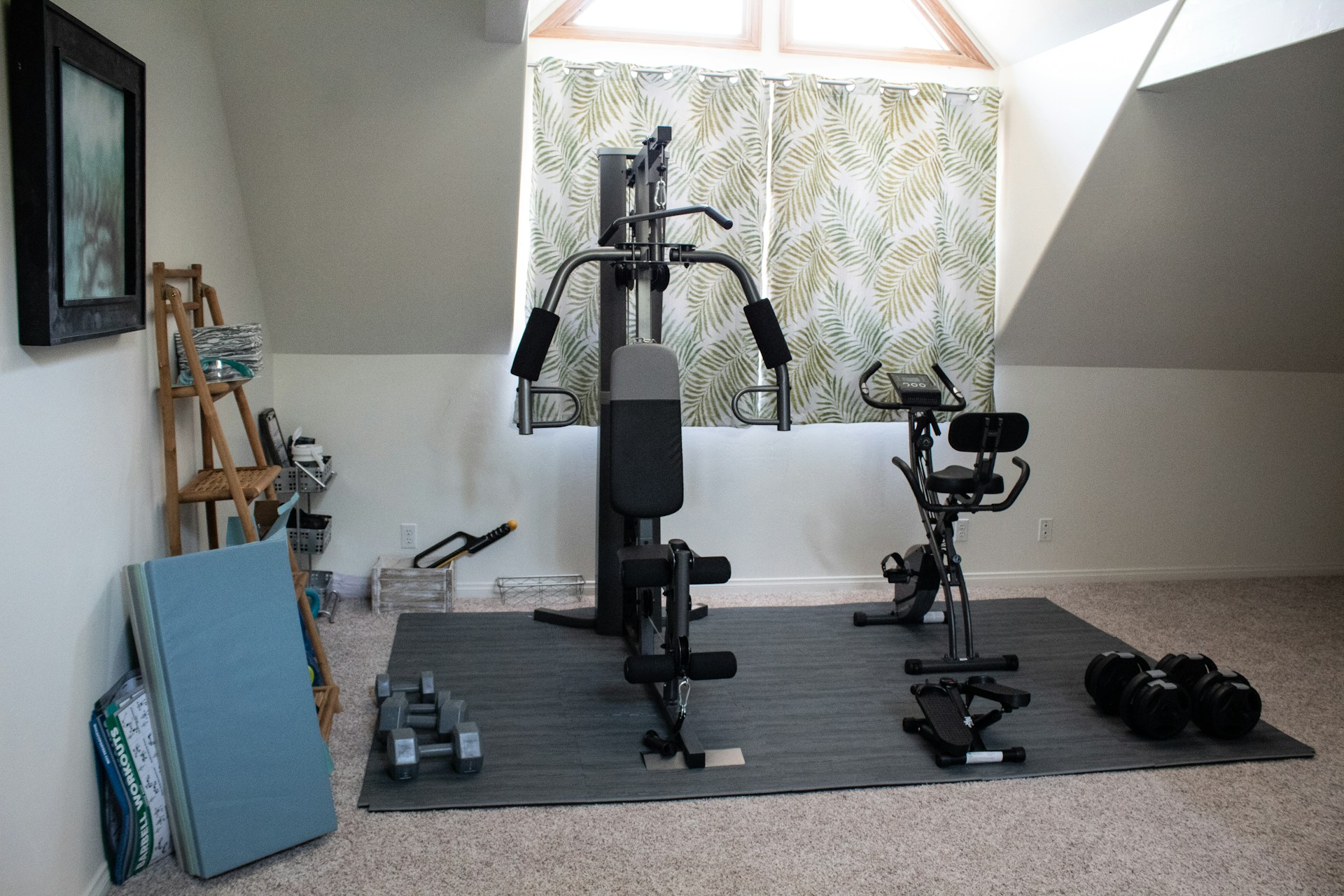
- Location and Layout: Good ventilation, ample natural light, and an open layout can make the space more inviting and conducive to workouts. Consider spare bedrooms, basements, garages, or even a sturdy shed.
- Essential Equipment: This is highly personal and can range from basic items like yoga mats, resistance bands, and dumbbells to larger machines such as treadmills, stationary bikes, rowing machines, or comprehensive weightlifting setups. Modern options include adjustable weight systems and smart fitness mirrors offering interactive training sessions.
- Flooring: The ideal flooring should be durable and shock-absorbing to protect joints and the subfloor. Rubber flooring, vinyl tiles, or specialized gym mats are excellent choices. If using an existing floor, ensure it's protected with heavy-duty mats, especially under equipment.
- Storage: Effective organization is key to a functional and motivating workout space. Utilize bookshelves, stackable totes, wall-mounted racks, or DIY pegboards to store smaller items like weights, bands, towels, and yoga mats neatly.
- Ambiance: Mirrors are beneficial not only for checking form during exercises but also for making the space feel larger and brighter. Consider uplifting wall colors, adequate and energizing lighting (perhaps tunable for different workout intensities), and a good sound system for music or guided workouts. Budget-friendly ideas include repurposing existing furniture for storage or creating a DIY pegboard organizer.
Cultivate Calm: Crafting Yoga and Meditation Nooks
A dedicated space for yoga and meditation can become a personal sanctuary, promoting mindfulness, reducing stress, and improving focus.
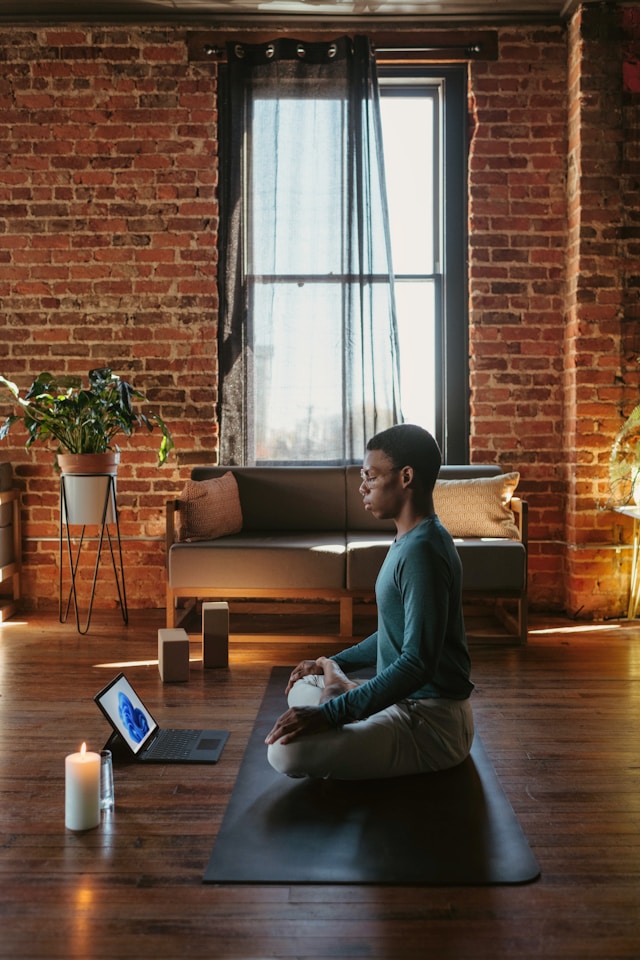
- Purpose and Location: The primary aim is to create an environment free from distractions where one can comfortably engage in mindfulness practices. Select a quiet spot in the home, away from high-traffic areas like the kitchen or main living room. A corner of a bedroom, an underused closet, a sunroom, or a screened-off section of a larger room can work well. Proximity to natural light is highly beneficial.
- Minimalism and Decluttering: A clutter-free environment is essential for mental clarity and relaxation. Keep the space simple and intentional, with only items that contribute to its calming energy and function.
- Flooring: Comfort, stability, and a non-slip surface are important for yoga and seated meditation.
- Cork: Offers a soft, warm, and naturally antimicrobial surface that is also sound-absorbent, making it excellent for quiet practices.
- Bamboo: Provides a durable, eco-friendly option with a natural, earthy aesthetic.
- Hardwood or Engineered Hardwood: Beautiful, stable, and easy to clean, providing a solid foundation for practice.
- Rubber: Offers excellent slip resistance and shock absorption, suitable if the space also accommodates more active movement.
- Regardless of the base flooring, a good quality yoga mat is essential for cushioning and grip.
- Acoustics for Quiet & Meditation Zones: Minimizing noise distractions is crucial for a meditative environment.
- Sound Absorption Techniques: Soft materials are key. Incorporate plush rugs, cushions, heavy curtains, or tapestries to absorb sound and reduce echo. Bookshelves filled with books can also diffuse sound. Aesthetically pleasing acoustic panels are available and can be effective.
- Sound Masking: If external noise is unavoidable, a white noise machine or apps playing calming nature sounds (like gentle rain or flowing water) can help create a consistent and soothing auditory backdrop. A small, quiet indoor water feature can also contribute to a tranquil soundscape.
- Structural Solutions (for renovations): For more significant soundproofing, consider noise-dampening insulation within walls or decoupling drywall from framing.
- Decor and Ambiance: The visual and sensory atmosphere should promote calm.
- Color Palette: Opt for soft, calming colors such as light blues, greens, grays, violets, or earthy neutrals.
- Lighting: Soft, warm, and dimmable lighting is ideal. Use lamps, string lights, or flameless candles to create a gentle glow, avoiding harsh overhead lights.
- Natural Elements: Incorporate plants known for their calming presence (like a Peace Lily), smooth stones, or wooden accents.
- Aromatherapy: Essential oil diffusers with calming scents like lavender, chamomile, or sandalwood can enhance relaxation.
- Personal Touches: Include items that hold personal significance and support the practice, such as a comfortable meditation cushion or bench, a small altar with meaningful objects, or inspiring artwork.
- Budget/DIY for Meditation Spaces: Creating a serene nook doesn't require a large budget. Repurpose an unused corner, create DIY decor like painted stones or simple wall hangings, use foraged natural elements like branches or shells, and employ inexpensive soundproofing methods like hanging heavy blankets or placing thick rugs.
The very act of designing and dedicating a space for wellness, no matter how small, signifies an intentional commitment to self-care. This conscious decision-making process can, in itself, yield psychological benefits, fostering a sense of agency and mindfulness even before the space is regularly used.
There's a notable synergy between effective acoustic design for quiet zones and the principles of biophilic design. For instance, strategies to absorb sound and reduce echo often involve using soft, natural materials like wool or cotton textiles, or cork for flooring and wall treatments – all of which align with biophilic goals of incorporating natural materials and textures. Furthermore, introducing natural soundscapes, such as the gentle sound of a water feature or recorded nature sounds, can enhance the tranquility of a meditation space while also fulfilling the biophilic pattern of non-visual connection to nature.
In an era where remote and hybrid work models are increasingly common, the importance of well-designed home environments that support both productivity and well-being is paramount. Ergonomic considerations for home offices are crucial, but equally important is the ability to mentally disengage from work. Dedicated wellness spaces, such as a home gym or a quiet meditation nook, provide essential physical and mental separation from work areas, fostering better work-life balance and protecting mental health. These zones offer a necessary retreat and a clear signal to the mind to switch off, relax, or recharge.
Wellness Within Reach: Budget-Friendly Upgrades & Prioritization
Transforming a home into a wellness sanctuary does not always necessitate extensive renovations or substantial financial outlay. Many impactful upgrades can be achieved with strategic choices, DIY efforts, and a focus on what truly enhances daily well-being, making a healthier home accessible across various budgets.
High-Impact, Low-Cost DIY Ideas
Several simple, often DIY-friendly, changes can significantly boost a home's wellness quotient:
- Declutter and Organize: This is perhaps the most cost-effective wellness upgrade. A tidy, organized space reduces mental clutter, lowers stress levels, and creates a more calming environment. The cost can be minimal, primarily for storage solutions like baskets or shelves if needed.
- Introduce Houseplants: As discussed earlier, plants improve air quality and bring a touch of nature indoors, enhancing mood and tranquility. Small plants or those propagated from cuttings can be very inexpensive.
- A Fresh Coat of (Low-VOC) Paint: Color has a powerful effect on mood. A new coat of paint in calming blues or greens, or energizing yet soft yellows, can transform a room's ambiance. Opting for low-VOC paints ensures this refresh is also healthy. Paint costs typically range from $20-50 per gallon.
- Lighting Enhancements: Simple changes like swapping existing bulbs for warmer tones in the evenings, especially in bedrooms and living areas, can support better sleep. Installing dimmer switches allows for adjustable mood lighting. Entry-level smart bulbs offer basic circadian support and color-tuning capabilities at a relatively low cost.
- Aromatherapy: Utilizing essential oil diffusers with calming scents like lavender or uplifting ones like citrus, or lighting natural soy or beeswax candles, can significantly influence mood and create a relaxing atmosphere. Diffusers and oils can be purchased for $10-30.
- Textile Upgrades: Introducing soft, plush towels in the bathroom, a cozy new throw blanket for the sofa, or a natural fiber rug can enhance comfort and the sensory experience of a space. These items can often be found at budget-friendly price points.
- Create a Small Meditation or Quiet Corner: Designate a small, comfortable spot for relaxation. This might involve rearranging existing furniture to create a nook, adding a few cushions, a soft blanket, and a calming plant. The cost can be virtually zero if repurposing existing items.
- Improve Natural Light & Airflow: Regularly cleaning windows, replacing heavy drapes with sheer curtains or blinds that allow light to filter through, and consistently opening windows for a few minutes each day to let in fresh air are free yet effective ways to brighten a space and improve air quality.
Prioritizing Your Wellness Investments
When financial resources are limited, prioritizing upgrades becomes essential. A thoughtful approach ensures that investments yield the most significant benefits for health and well-being.
- Assess Personal Needs and Goals: The first step is to identify which aspects of wellness are most crucial for the household. Is it improved sleep, reduced allergies, a more calming environment, or space for physical activity? Understanding these priorities will guide decision-making.
- Adopt a Phased Approach: Wellness upgrades can be implemented incrementally. Tackling projects in stages makes them more manageable both financially and logistically.
- A Hierarchy of Upgrades: Expert advice often suggests a specific order for renovations:
- Critical Repairs First: Address any foundational issues that compromise health and safety, such as structural problems, water leaks (which can lead to mold), outdated or faulty electrical systems, and malfunctioning HVAC systems. These are non-negotiable for a truly healthy home.
- Upgrades Enhancing Daily Living: Next, focus on improvements that significantly impact daily functionality and comfort. This could include enhancing indoor air and water quality, optimizing lighting, or making functional improvements to high-use areas like kitchens and bathrooms.
- Luxury Additions Last: Features like high-end spa bathrooms, extensive home gyms with specialized equipment, or elaborate smart home integrations should generally be considered after essential health and functional needs are met.
- Focus on High Return on Investment (ROI) - for Well-being and Value: Certain upgrades tend to offer a strong return, not only in terms of potential property value but also in daily well-being. These often include kitchen and bathroom updates (focusing on functionality and non-toxic materials), improvements to air and water quality, strategic lighting upgrades, and enhancements to energy efficiency.
DIY vs. Professional: Making the Right Choice
Deciding whether to undertake a wellness upgrade as a DIY project or hire a professional involves weighing costs, time, skill, and potential risks.
- DIY Advantages: The most significant benefit is labor cost savings, which can be substantial (potentially 20-40% of project costs). DIY also offers complete creative control over the project and the satisfaction of developing new skills.
- DIY Disadvantages: Projects often take considerably longer to complete due to the learning curve and limited time availability. There's a higher risk of mistakes, which can lead to costly repairs (sometimes $10,000-$20,000 for unforeseen issues), inconsistent quality, and potential safety or regulatory issues if permits are required and not obtained, or if work isn't up to code.
- Professional Advantages: Hiring professionals brings expertise, experience, and efficiency, generally resulting in higher quality workmanship and a faster project completion time. They manage the project from start to finish, often providing access to better materials or trade discounts.
- Professional Disadvantages: The primary drawback is the higher upfront cost due to labor charges.
- When to Call a Professional: It is generally advisable to hire qualified professionals for complex tasks involving electrical wiring, plumbing, HVAC systems, structural alterations, and any work that requires permits or specialized knowledge to ensure safety and compliance.
The most impactful wellness upgrades on a limited budget are often those addressing fundamental physiological and psychological needs. Prioritizing clean air through houseplants and basic purifiers, ensuring access to filtered drinking water with point-of-use filters, optimizing natural and artificial light for better circadian rhythms, choosing non-toxic paints, and creating decluttered, nature-connected quiet spaces tend to offer the best "wellness return on investment". These foundational improvements can often be achieved at a lower cost than major renovations.
A valuable, yet often overlooked, initial step for any homeowner, regardless of budget, is to conduct a personal "wellness audit" of their home. This involves mindfully assessing how different aspects of the living environment—such as light, air quality, noise levels, organization, and connection to nature—currently impact their well-being. By identifying specific areas that cause stress or discomfort, or where small changes could yield significant positive effects, homeowners can create a personalized roadmap for upgrades. This self-assessment makes the process of budgeting and prioritizing wellness investments far more targeted and effective. The very concept of "wellness" in home design is becoming more accessible, moving beyond an exclusive association with luxury. The increasing availability of budget-friendly options, DIY guidance, and a broader understanding of foundational health principles in design means that creating healthier living environments is an attainable goal for a wider range of homeowners.
The Evolving Healthy Home: Future Trends
The pursuit of well-being within our homes is a dynamic field, continually shaped by technological advancements and a deeper understanding of the human-environment interaction. The healthy home of the future is poised to be even more intuitive, personalized, and seamlessly integrated with our wellness needs.
Emerging innovations in wellness architecture and home technology point towards increasingly sophisticated living environments:
- AI-Powered Bio-Tracking and Adaptive Environments: Future homes may feature integrated sensor networks and artificial intelligence that monitor occupants' physiological and emotional states. This data could then be used to dynamically adjust environmental conditions—such as lighting intensity and color temperature, ambient temperature, air quality parameters, and even soundscapes—to optimize well-being in real-time, creating spaces that actively respond to and support individual needs.
- Advanced Smart Home Health Technologies: The integration of health tech is likely to deepen. Imagine circadian lighting systems that synchronize not only with the time of day but also with smart beds that monitor sleep patterns, or home fitness spaces enhanced by AI-powered virtual trainers and recovery systems that adapt to biometric feedback.
- Silent Architecture and Low-EMF Design: As awareness of sensory overload and potential impacts of electromagnetic fields (EMFs) grows, there's an increasing focus on "Silent Architecture." This involves designing spaces for acoustic wellness through advanced soundproofing, sound-absorbing materials, and biophilic soundscapes, as well as strategies to minimize exposure to EMFs from wireless devices and electrical systems.
- Regenerative Development: Beyond individual home wellness, a broader trend is regenerative development. This holistic approach to building considers the health of the entire ecosystem, focusing on designs and materials that restore and enhance the natural environment and support community well-being, rather than merely minimizing harm.
- Continued Growth of Health-Centric Real Estate: The demand for homes designed with health and wellness as core priorities is expected to continue its upward trajectory. This will likely drive further innovation in wellness-related building products, technologies, and design practices.
- Sophisticated Nature Mimicry through Technology: While direct connection to nature remains paramount, technology will offer more advanced ways to mimic natural patterns, light cycles, and elements within indoor environments where direct access is limited. This could include dynamic digital art that reflects natural scenes or advanced lighting that more accurately replicates the full spectrum and variability of sunlight.
The overarching direction is towards homes that are not just passive shelters but active partners in maintaining and enhancing our health. The future healthy home promises to be highly personalized, using technology to create adaptive environments that cater to the unique, real-time wellness needs of its occupants. This signifies a shift from static design features to dynamic, responsive systems that engage with inhabitants on a deeper physiological and psychological level.
As these advanced wellness technologies mature and achieve wider adoption, the associated costs are likely to decrease due to economies of scale and increased market competition. Features that are currently considered high-end or luxury, such as fully integrated AI-driven environmental controls or comprehensive low-EMF construction, may become more mainstream and accessible. This evolution holds the promise of making sophisticated, proactively healthy home environments attainable for a broader segment of the population, further embedding wellness into the very fabric of residential design.
Conclusion: Cultivating Your Personal Haven
The journey to a healthier home is a deeply personal and rewarding one. By consciously addressing the key pillars of a wellness-focused living environment—ensuring clean air and pure water, harnessing the power of supportive lighting, fostering a connection with nature through biophilic design, choosing non-toxic and sustainable materials, and carving out dedicated spaces for physical and mental well-being—homeowners can profoundly enhance their quality of life.
It is important to remember that creating a healthy home is an ongoing process, not a one-time destination. The most effective approach is often incremental, starting with upgrades that resonate most strongly with individual needs, lifestyle, and budget. Whether it's the simple act of adding a few air-purifying plants or investing in a comprehensive water filtration system, each step taken contributes to a living space that better supports health and happiness. The process of intentionally designing and improving one's home for wellness can, in itself, be a mindful and therapeutic activity, fostering a deeper connection to one's surroundings and a sense of agency over personal well-being even before the physical upgrades are fully realized.
Ultimately, the goal is to cultivate a personal haven—a home that not only shelters but also nurtures, rejuvenates, and inspires. An investment in a wellness-focused home is an investment in oneself and one's family, promising returns in the form of improved physical health, greater mental clarity, reduced stress, and an enhanced sense of overall life satisfaction. A home designed with well-being at its core can provide a stable and supportive foundation from which to navigate the complexities of life, positively influencing everything from personal relationships to productivity and creativity. The true reward lies in creating a living environment that truly feels like a sanctuary.